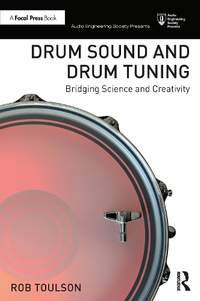
Drum Sound and Drum Tuning: Bridging Science and Creativity
- Author: Toulson, Rob
Book
$183.50Printed on demand
Contents
- List of Figures
- List of Tables
- 1 Introduction
- 1.1 Values of Great Drum Sound
- 1.2 Why Bother with Drum Tuning?
- 1.3 About this Book
- 1.3.1 Educational Approach
- 1.3.2 Online Resources
- 1.3.3 Interviews with Esteemed Professionals
- 1.3.4 Companion Software and Examples
- 1.4 Don't Forget to Listen!
- 2 Drumhead Vibration and the Science of Sound
- 2.1 Sound Sources, Acoustic Transmission and Sound Reception
- 2.2 Evaluating Frequencies
- 2.3 The Single Most Valuable Musical Acoustics Theory!
- 2.4 Measuring and Analysing Drum Modes
- 3 Tuning the Pitch of a Cylindrical Drum
- 3.1 Exploring the Pitch Range of a Cylindrical Drum
- 3.2 Musical Frequencies
- 3.3 Coupled Drumheads
- 4 Lug Tuning and Clearing the Drumhead
- 4.1 Evaluating the First Overtone of a Drum
- 4.2 Beat Frequencies
- 4.3 The Sound of a Uniformly Tuned Drumhead
- 4.4 Lug Tuning with Assistance
- 5 Tuning the Resonant Drumhead - What, Why and How?
- 5.1 Harmonics and In-Harmonic Overtones
- 5.2 Musical Intervals
- 5.3 Controlling Overtones and Intervals with the Resonant Drumhead
- 6 A Holistic Approach to Drum Tuning
- 6.1 Simplicity Wins
- 6.2 Setting the Fundamental Pitch
- 6.3 Implementing Lug Tuning and Resonant Head Tuning
- 6.4 Damping and Decay Times
- 7 The Wonderful World of Drumheads
- 7.1 Guitar Strings on Steroids!
- 7.2 The Drumhead Equation
- 7.3 Drumhead Types and Features
- 7.4 Resonant Drumhead Selection
- 7.5 Experience Drumheads!
- 8 Timbre: The Truth about Drum Shell Vibration
- 8.1 Introducing Timbre
- 8.2 Tuning Fork Example with Mass Loading
- 8.3 Drum Shell Vibration
- 8.4 Loading the Drum Shell
- 8.5 Bearing Edges and Precision Manufacturing
- 8.6 Considering the Drum Shell Vibration Frequency when Tuning
- 9 Tuning for Different Musical Styles and Genres
- 9.1 Creative Objectives
- 9.2 Drum Sizes for Different Music Genres
- 9.3 Pitches and Intervals on the Kit
- 9.4 Tuning Suggestions for Different Genres
- 9.5 Drumheads for Different Music Genres
- 10 Snare Drum Tuning
- 10.1 Key Aspects of Snare Tuning
- 10.2 Holistic Approach to Snare Tuning
- 10.3 Manipulating Snare Drum Timbre
- 10.4 Comparing Snare Timbre Example
- 11 Kick Drum Tuning
- 11.1 Kick Drum Tone and Dynamics
- 11.2 Drumheads for the Kick Drum
- 11.3 Kick Drum Tuning Range
- 11.4 Controlling the Kick Drum Timbre
- 12 Production and Preparation for Drum Recording
- 12.1 Production and Pre-Production
- 12.2 Setting Standards and Getting Results
- 12.3 Choosing and Evaluating the Recording Space
- 12.3.1 Room Size and Dimensions
- 12.3.2 Room Materials and Reverberation Characteristics
- 12.3.3 Sound Isolation and Background Noise Levels
- 12.3.4 Suitability for a Room's Use in a Recording Project
- 12.3.5 Positioning Drums within a Room
- 12.4 Tuning and Performance for Recording
- 13 Fundamental Technologies for Drum Recording
- 13.1 Microphones and Transducers
- 13.1.1 Dynamic Microphones
- 13.1.2 Condenser Microphones
- 13.1.3 Ribbon Microphones
- 13.1.4 Other Audio Transducers
- 13.2 Microphone Characteristics
- 13.2.1 Microphone Polar Patterns
- 13.2.2 Other Microphone Characteristics
- 13.3 The Complete Recording Signal Chain
- 13.3.1 Audio Convertors
- 13.3.2 Mixing Desk
- 13.3.3 Microphone Preamplifiers
- 13.3.4 Recording with FX
- 13.4 Monitoring and Foldback
- 13.4.1 Control Room Monitoring
- 13.4.2 Headphone Foldback
- 14 We Need to Talk About Phase!
- 14.1 What Exactly is Phase?
- 14.2 Time Delay and Comb Filtering
- 14.3 Mono Compatibility
- 14.4 Signal Polarity
- 15 Microphone Techniques for Recording Drums
- 15.1 Microphone Placement Approaches
- 15.2 Stereo Recording for Drums
- 15.2.1 Defining The Stereo Field
- 15.2.2 Spaced Pair Technique
- 15.2.3 X-Y Technique
- 15.2.4 Blumlein Pair Technique
- 15.2.5 ORTF Technique
- 15.2.6 Mid-Side Technique
- 15.2.7 Baffled Omnidirectional Pair Technique
- 15.2.8 Decca Tree Technique
- 15.2.9 Left-Right-Center Technique
- 15.3 Using Spot Microphone Techniques
- 15.3.1 Kick Drum Microphone Technique
- 15.3.2 Snare Drum Microphone Technique
- 15.3.3 Tom Drum Microphone Technique
- 15.3.4 Close Cymbal Microphone Technique
- 15.4 Room Microphones
- 15.5 Microphone Choices for Recording Drums
- 15.6 Developing a Personal Approach
- 16 Mixing Drums: Balance and Dynamics
- 16.1 Balance, Panning and Bussing
- 16.2 Dynamics Processing
- 16.2.1 Compression and Limiting
- 16.2.2 Gates and Expanders
- 16.2.3 Envelope Shaping
- 16.3 Hybrid mixing
- 17 Mixing Drums: Creative Processing
- 17.1 Equalisation and Spectral Processing
- 17.1.1 Cutting Low Frequencies
- 17.1.2 Treating the Fundamental and Overtones of Each Drum
- 17.1.3 Adding Attack and Presence
- 17.1.4 Controlling High Frequencies
- 17.2 Using Reverb to Regain Authenticity
- 17.3 Delay for Drums
- 17.4 Distortion and Enhancers
- 17.5 Sequential and Sidechain and Processing
- 17.6 Drum Replacement
- 17.7 The Final Mixdown
- Index



